Contemporary issues in information technology Assignment 2022
VerifiedAdded on 2022/10/07
|11
|3434
|56
Assignment
AI Summary
Contribute Materials
Your contribution can guide someone’s learning journey. Share your
documents today.
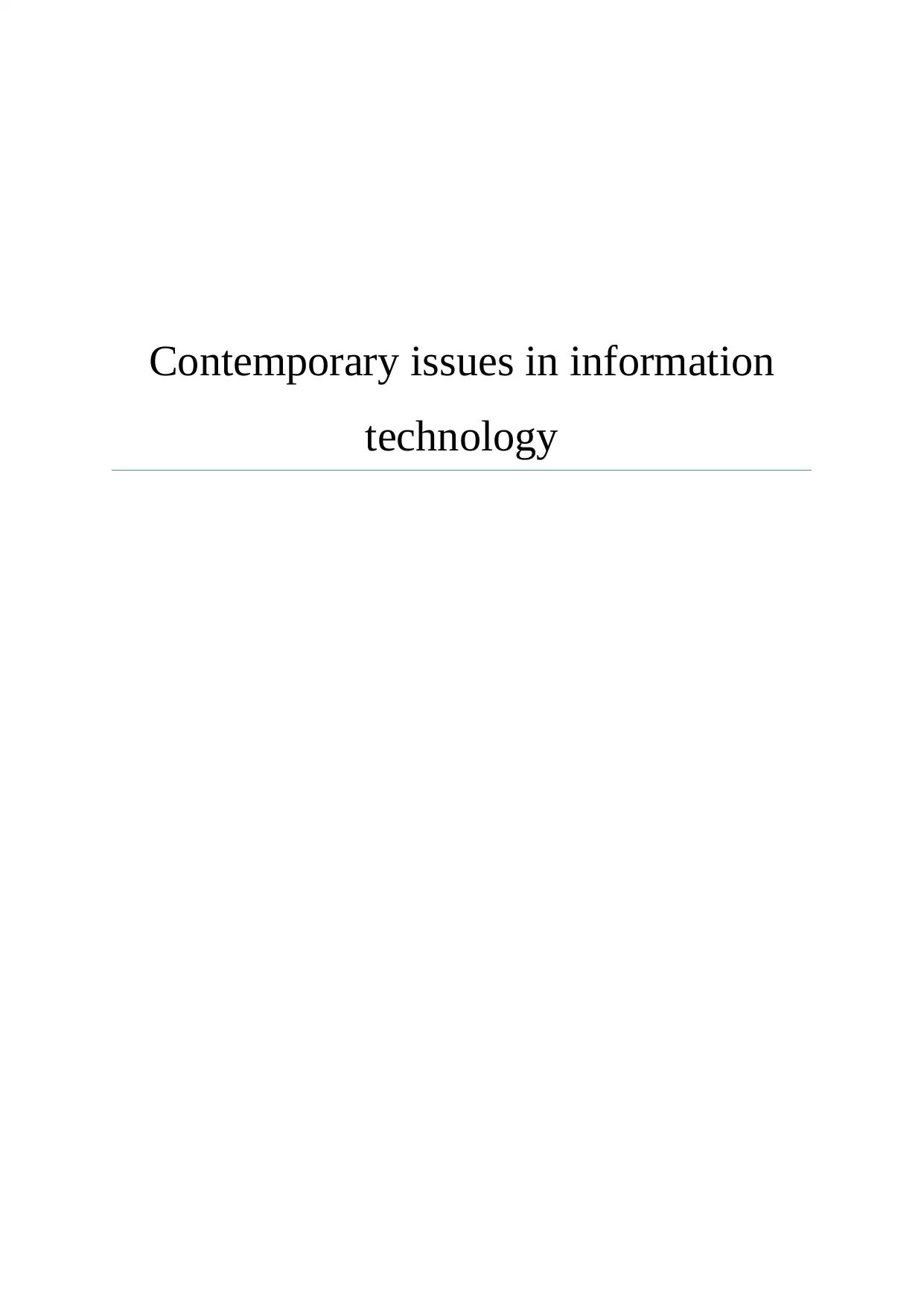
Contemporary issues in information
technology
technology
Secure Best Marks with AI Grader
Need help grading? Try our AI Grader for instant feedback on your assignments.
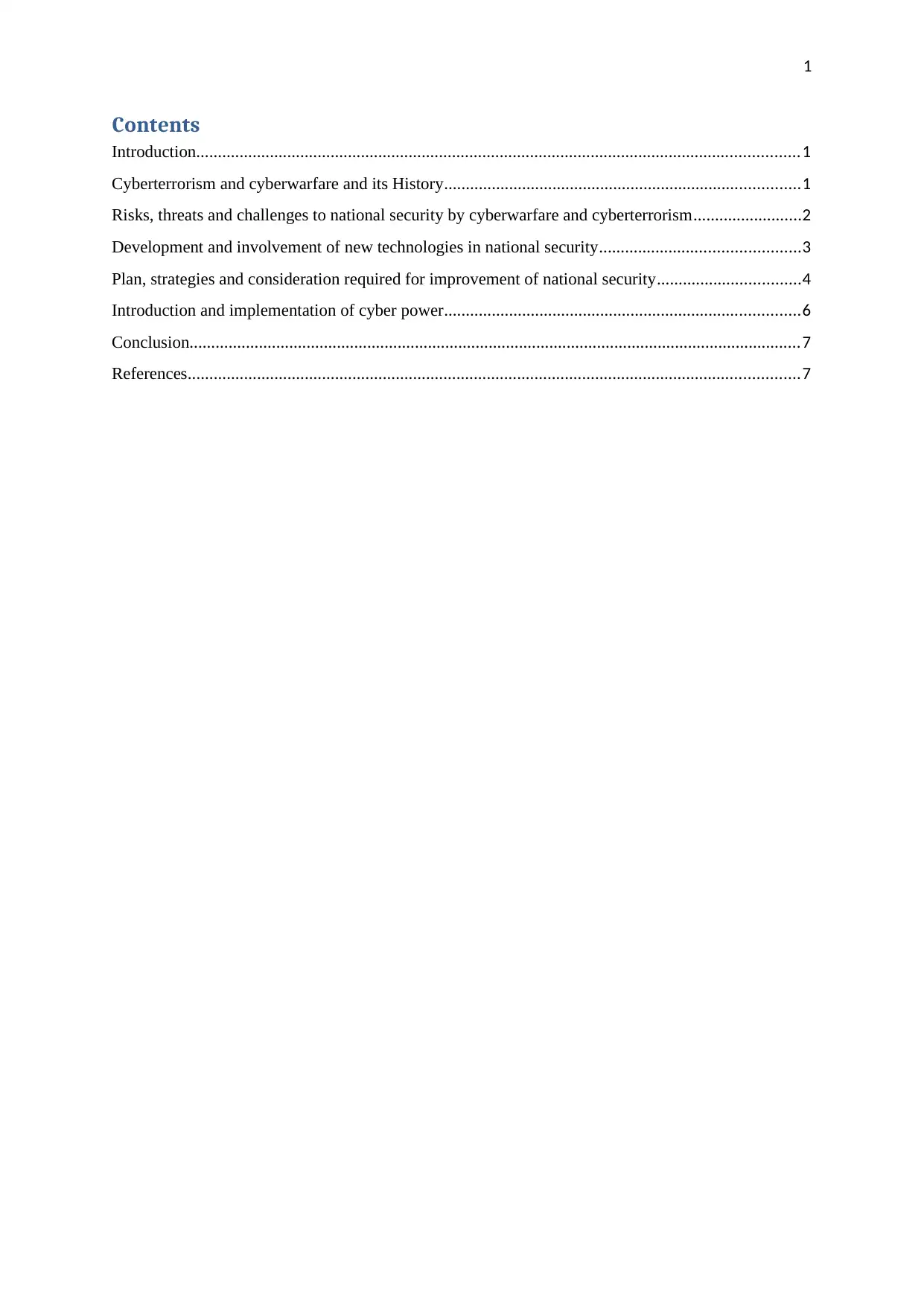
1
Contents
Introduction...........................................................................................................................................1
Cyberterrorism and cyberwarfare and its History..................................................................................1
Risks, threats and challenges to national security by cyberwarfare and cyberterrorism.........................2
Development and involvement of new technologies in national security..............................................3
Plan, strategies and consideration required for improvement of national security.................................4
Introduction and implementation of cyber power..................................................................................6
Conclusion.............................................................................................................................................7
References.............................................................................................................................................7
Contents
Introduction...........................................................................................................................................1
Cyberterrorism and cyberwarfare and its History..................................................................................1
Risks, threats and challenges to national security by cyberwarfare and cyberterrorism.........................2
Development and involvement of new technologies in national security..............................................3
Plan, strategies and consideration required for improvement of national security.................................4
Introduction and implementation of cyber power..................................................................................6
Conclusion.............................................................................................................................................7
References.............................................................................................................................................7
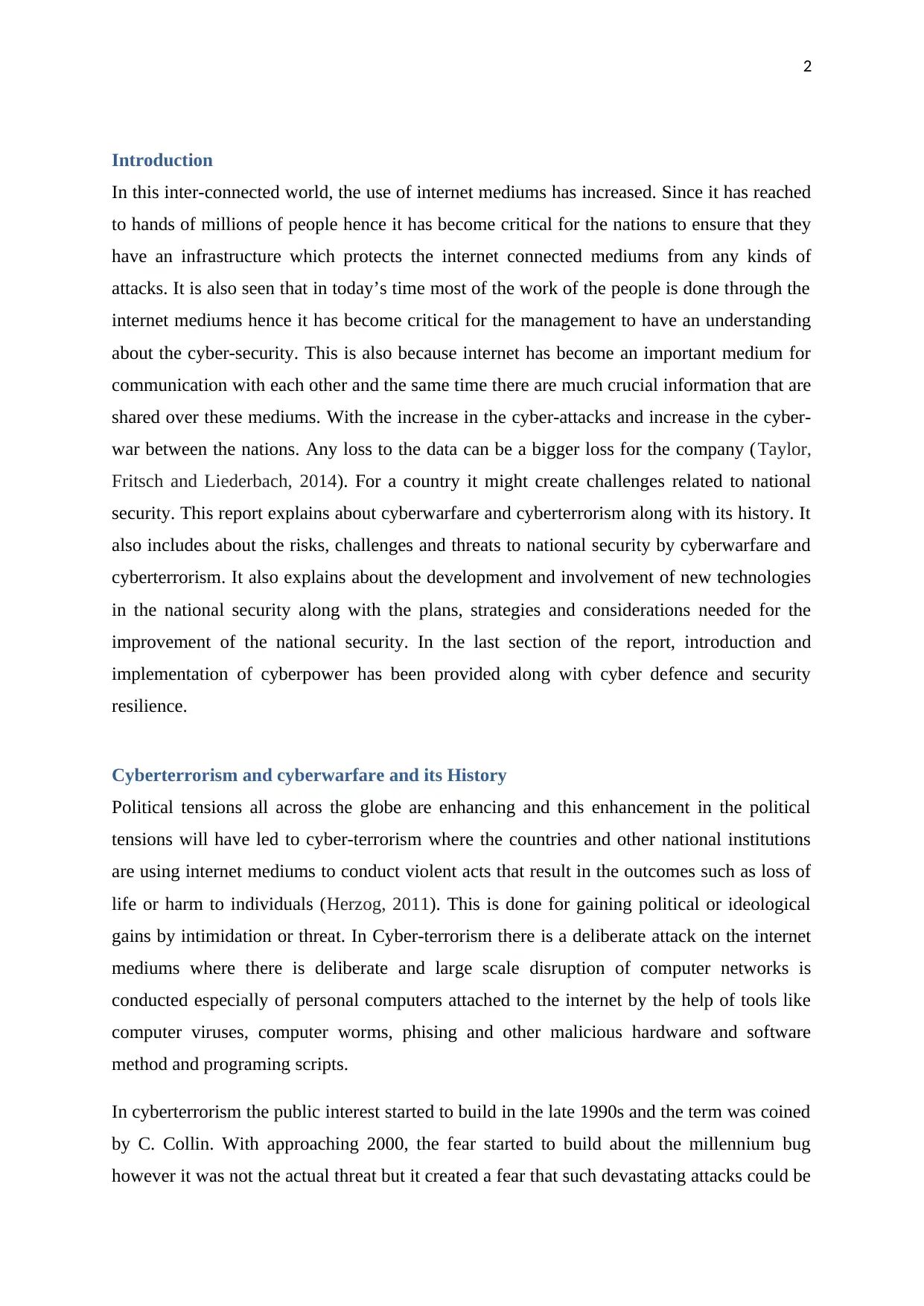
2
Introduction
In this inter-connected world, the use of internet mediums has increased. Since it has reached
to hands of millions of people hence it has become critical for the nations to ensure that they
have an infrastructure which protects the internet connected mediums from any kinds of
attacks. It is also seen that in today’s time most of the work of the people is done through the
internet mediums hence it has become critical for the management to have an understanding
about the cyber-security. This is also because internet has become an important medium for
communication with each other and the same time there are much crucial information that are
shared over these mediums. With the increase in the cyber-attacks and increase in the cyber-
war between the nations. Any loss to the data can be a bigger loss for the company (Taylor,
Fritsch and Liederbach, 2014). For a country it might create challenges related to national
security. This report explains about cyberwarfare and cyberterrorism along with its history. It
also includes about the risks, challenges and threats to national security by cyberwarfare and
cyberterrorism. It also explains about the development and involvement of new technologies
in the national security along with the plans, strategies and considerations needed for the
improvement of the national security. In the last section of the report, introduction and
implementation of cyberpower has been provided along with cyber defence and security
resilience.
Cyberterrorism and cyberwarfare and its History
Political tensions all across the globe are enhancing and this enhancement in the political
tensions will have led to cyber-terrorism where the countries and other national institutions
are using internet mediums to conduct violent acts that result in the outcomes such as loss of
life or harm to individuals (Herzog, 2011). This is done for gaining political or ideological
gains by intimidation or threat. In Cyber-terrorism there is a deliberate attack on the internet
mediums where there is deliberate and large scale disruption of computer networks is
conducted especially of personal computers attached to the internet by the help of tools like
computer viruses, computer worms, phising and other malicious hardware and software
method and programing scripts.
In cyberterrorism the public interest started to build in the late 1990s and the term was coined
by C. Collin. With approaching 2000, the fear started to build about the millennium bug
however it was not the actual threat but it created a fear that such devastating attacks could be
Introduction
In this inter-connected world, the use of internet mediums has increased. Since it has reached
to hands of millions of people hence it has become critical for the nations to ensure that they
have an infrastructure which protects the internet connected mediums from any kinds of
attacks. It is also seen that in today’s time most of the work of the people is done through the
internet mediums hence it has become critical for the management to have an understanding
about the cyber-security. This is also because internet has become an important medium for
communication with each other and the same time there are much crucial information that are
shared over these mediums. With the increase in the cyber-attacks and increase in the cyber-
war between the nations. Any loss to the data can be a bigger loss for the company (Taylor,
Fritsch and Liederbach, 2014). For a country it might create challenges related to national
security. This report explains about cyberwarfare and cyberterrorism along with its history. It
also includes about the risks, challenges and threats to national security by cyberwarfare and
cyberterrorism. It also explains about the development and involvement of new technologies
in the national security along with the plans, strategies and considerations needed for the
improvement of the national security. In the last section of the report, introduction and
implementation of cyberpower has been provided along with cyber defence and security
resilience.
Cyberterrorism and cyberwarfare and its History
Political tensions all across the globe are enhancing and this enhancement in the political
tensions will have led to cyber-terrorism where the countries and other national institutions
are using internet mediums to conduct violent acts that result in the outcomes such as loss of
life or harm to individuals (Herzog, 2011). This is done for gaining political or ideological
gains by intimidation or threat. In Cyber-terrorism there is a deliberate attack on the internet
mediums where there is deliberate and large scale disruption of computer networks is
conducted especially of personal computers attached to the internet by the help of tools like
computer viruses, computer worms, phising and other malicious hardware and software
method and programing scripts.
In cyberterrorism the public interest started to build in the late 1990s and the term was coined
by C. Collin. With approaching 2000, the fear started to build about the millennium bug
however it was not the actual threat but it created a fear that such devastating attacks could be
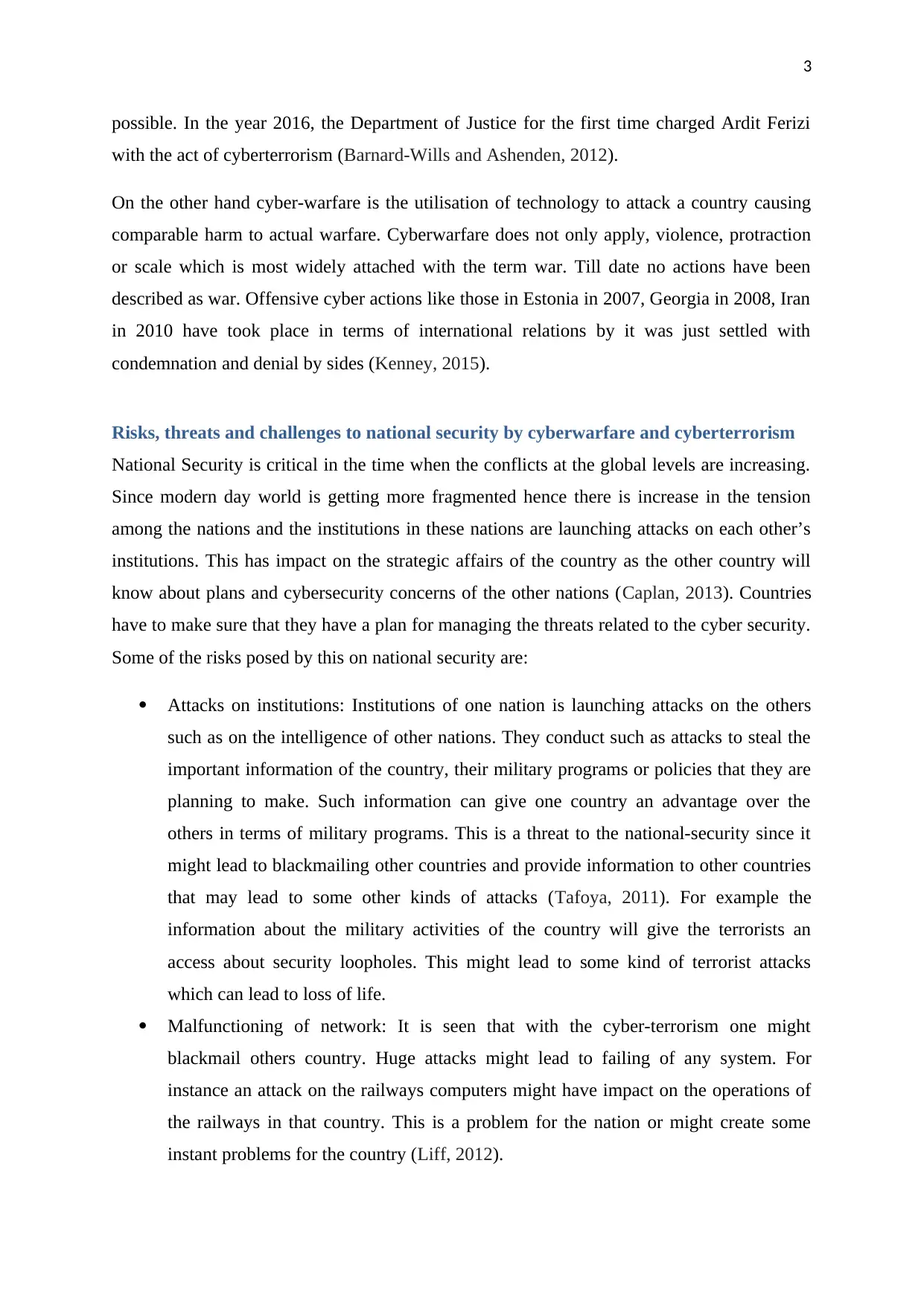
3
possible. In the year 2016, the Department of Justice for the first time charged Ardit Ferizi
with the act of cyberterrorism (Barnard-Wills and Ashenden, 2012).
On the other hand cyber-warfare is the utilisation of technology to attack a country causing
comparable harm to actual warfare. Cyberwarfare does not only apply, violence, protraction
or scale which is most widely attached with the term war. Till date no actions have been
described as war. Offensive cyber actions like those in Estonia in 2007, Georgia in 2008, Iran
in 2010 have took place in terms of international relations by it was just settled with
condemnation and denial by sides (Kenney, 2015).
Risks, threats and challenges to national security by cyberwarfare and cyberterrorism
National Security is critical in the time when the conflicts at the global levels are increasing.
Since modern day world is getting more fragmented hence there is increase in the tension
among the nations and the institutions in these nations are launching attacks on each other’s
institutions. This has impact on the strategic affairs of the country as the other country will
know about plans and cybersecurity concerns of the other nations (Caplan, 2013). Countries
have to make sure that they have a plan for managing the threats related to the cyber security.
Some of the risks posed by this on national security are:
Attacks on institutions: Institutions of one nation is launching attacks on the others
such as on the intelligence of other nations. They conduct such as attacks to steal the
important information of the country, their military programs or policies that they are
planning to make. Such information can give one country an advantage over the
others in terms of military programs. This is a threat to the national-security since it
might lead to blackmailing other countries and provide information to other countries
that may lead to some other kinds of attacks (Tafoya, 2011). For example the
information about the military activities of the country will give the terrorists an
access about security loopholes. This might lead to some kind of terrorist attacks
which can lead to loss of life.
Malfunctioning of network: It is seen that with the cyber-terrorism one might
blackmail others country. Huge attacks might lead to failing of any system. For
instance an attack on the railways computers might have impact on the operations of
the railways in that country. This is a problem for the nation or might create some
instant problems for the country (Liff, 2012).
possible. In the year 2016, the Department of Justice for the first time charged Ardit Ferizi
with the act of cyberterrorism (Barnard-Wills and Ashenden, 2012).
On the other hand cyber-warfare is the utilisation of technology to attack a country causing
comparable harm to actual warfare. Cyberwarfare does not only apply, violence, protraction
or scale which is most widely attached with the term war. Till date no actions have been
described as war. Offensive cyber actions like those in Estonia in 2007, Georgia in 2008, Iran
in 2010 have took place in terms of international relations by it was just settled with
condemnation and denial by sides (Kenney, 2015).
Risks, threats and challenges to national security by cyberwarfare and cyberterrorism
National Security is critical in the time when the conflicts at the global levels are increasing.
Since modern day world is getting more fragmented hence there is increase in the tension
among the nations and the institutions in these nations are launching attacks on each other’s
institutions. This has impact on the strategic affairs of the country as the other country will
know about plans and cybersecurity concerns of the other nations (Caplan, 2013). Countries
have to make sure that they have a plan for managing the threats related to the cyber security.
Some of the risks posed by this on national security are:
Attacks on institutions: Institutions of one nation is launching attacks on the others
such as on the intelligence of other nations. They conduct such as attacks to steal the
important information of the country, their military programs or policies that they are
planning to make. Such information can give one country an advantage over the
others in terms of military programs. This is a threat to the national-security since it
might lead to blackmailing other countries and provide information to other countries
that may lead to some other kinds of attacks (Tafoya, 2011). For example the
information about the military activities of the country will give the terrorists an
access about security loopholes. This might lead to some kind of terrorist attacks
which can lead to loss of life.
Malfunctioning of network: It is seen that with the cyber-terrorism one might
blackmail others country. Huge attacks might lead to failing of any system. For
instance an attack on the railways computers might have impact on the operations of
the railways in that country. This is a problem for the nation or might create some
instant problems for the country (Liff, 2012).
Secure Best Marks with AI Grader
Need help grading? Try our AI Grader for instant feedback on your assignments.
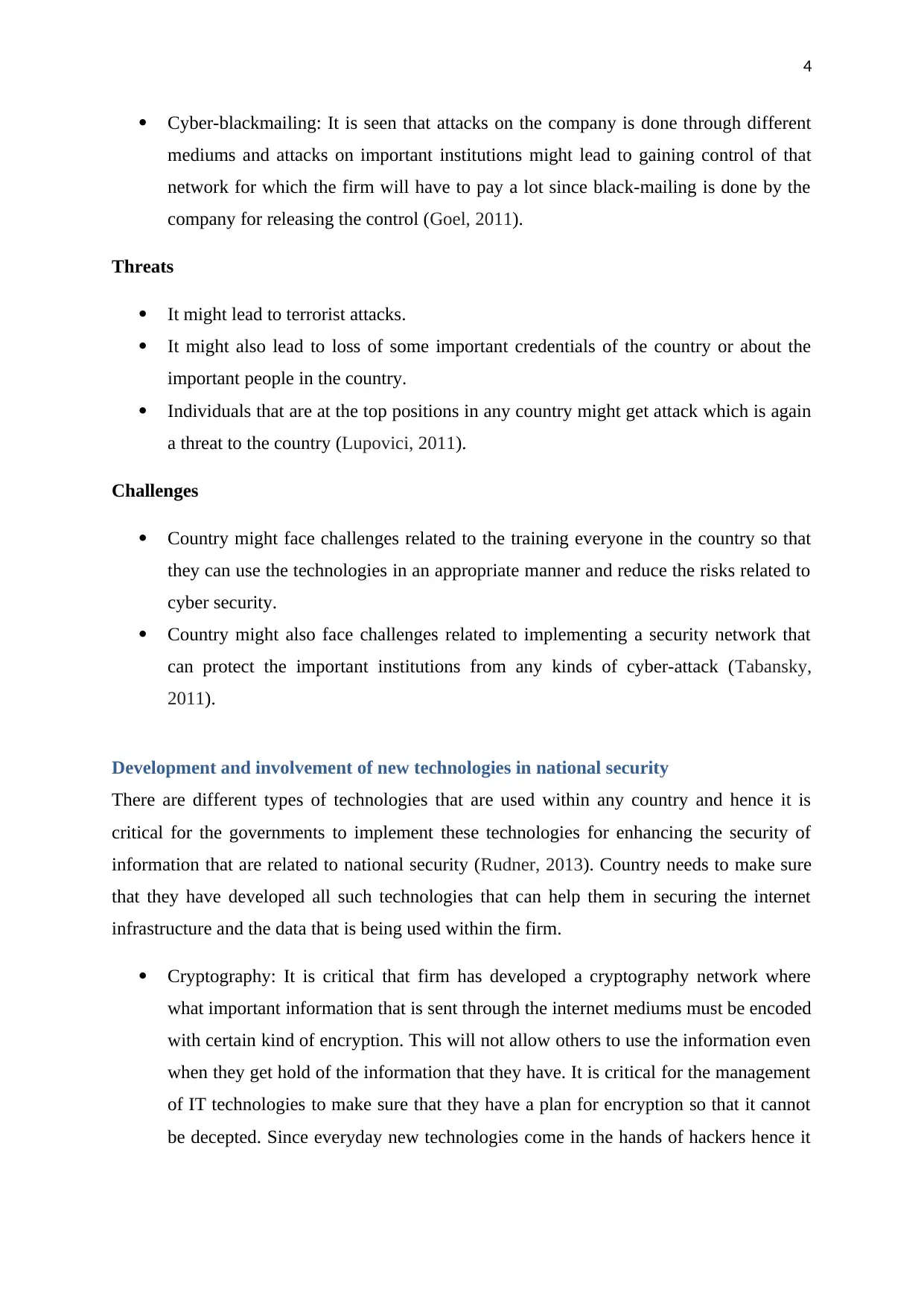
4
Cyber-blackmailing: It is seen that attacks on the company is done through different
mediums and attacks on important institutions might lead to gaining control of that
network for which the firm will have to pay a lot since black-mailing is done by the
company for releasing the control (Goel, 2011).
Threats
It might lead to terrorist attacks.
It might also lead to loss of some important credentials of the country or about the
important people in the country.
Individuals that are at the top positions in any country might get attack which is again
a threat to the country (Lupovici, 2011).
Challenges
Country might face challenges related to the training everyone in the country so that
they can use the technologies in an appropriate manner and reduce the risks related to
cyber security.
Country might also face challenges related to implementing a security network that
can protect the important institutions from any kinds of cyber-attack (Tabansky,
2011).
Development and involvement of new technologies in national security
There are different types of technologies that are used within any country and hence it is
critical for the governments to implement these technologies for enhancing the security of
information that are related to national security (Rudner, 2013). Country needs to make sure
that they have developed all such technologies that can help them in securing the internet
infrastructure and the data that is being used within the firm.
Cryptography: It is critical that firm has developed a cryptography network where
what important information that is sent through the internet mediums must be encoded
with certain kind of encryption. This will not allow others to use the information even
when they get hold of the information that they have. It is critical for the management
of IT technologies to make sure that they have a plan for encryption so that it cannot
be decepted. Since everyday new technologies come in the hands of hackers hence it
Cyber-blackmailing: It is seen that attacks on the company is done through different
mediums and attacks on important institutions might lead to gaining control of that
network for which the firm will have to pay a lot since black-mailing is done by the
company for releasing the control (Goel, 2011).
Threats
It might lead to terrorist attacks.
It might also lead to loss of some important credentials of the country or about the
important people in the country.
Individuals that are at the top positions in any country might get attack which is again
a threat to the country (Lupovici, 2011).
Challenges
Country might face challenges related to the training everyone in the country so that
they can use the technologies in an appropriate manner and reduce the risks related to
cyber security.
Country might also face challenges related to implementing a security network that
can protect the important institutions from any kinds of cyber-attack (Tabansky,
2011).
Development and involvement of new technologies in national security
There are different types of technologies that are used within any country and hence it is
critical for the governments to implement these technologies for enhancing the security of
information that are related to national security (Rudner, 2013). Country needs to make sure
that they have developed all such technologies that can help them in securing the internet
infrastructure and the data that is being used within the firm.
Cryptography: It is critical that firm has developed a cryptography network where
what important information that is sent through the internet mediums must be encoded
with certain kind of encryption. This will not allow others to use the information even
when they get hold of the information that they have. It is critical for the management
of IT technologies to make sure that they have a plan for encryption so that it cannot
be decepted. Since everyday new technologies come in the hands of hackers hence it
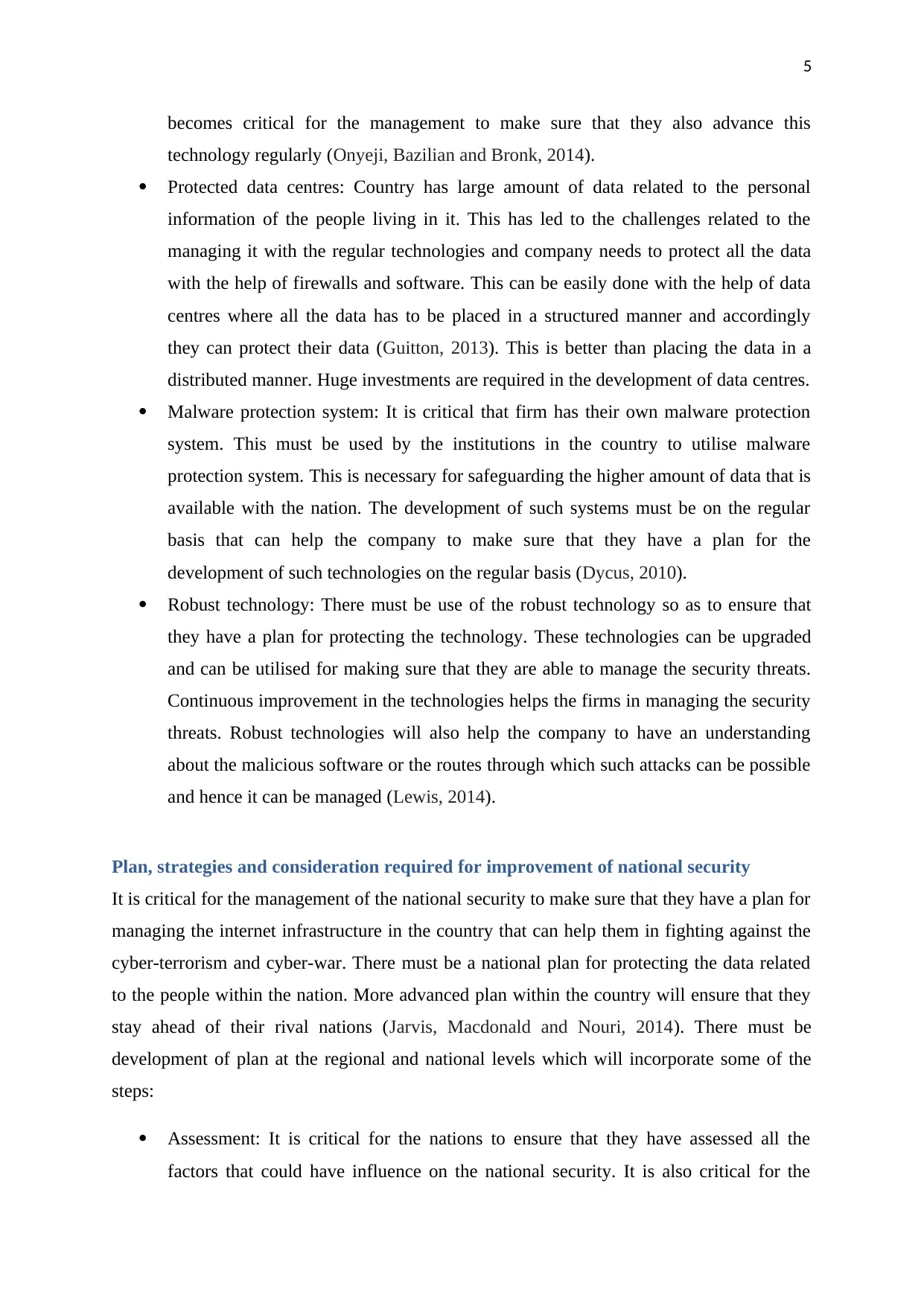
5
becomes critical for the management to make sure that they also advance this
technology regularly (Onyeji, Bazilian and Bronk, 2014).
Protected data centres: Country has large amount of data related to the personal
information of the people living in it. This has led to the challenges related to the
managing it with the regular technologies and company needs to protect all the data
with the help of firewalls and software. This can be easily done with the help of data
centres where all the data has to be placed in a structured manner and accordingly
they can protect their data (Guitton, 2013). This is better than placing the data in a
distributed manner. Huge investments are required in the development of data centres.
Malware protection system: It is critical that firm has their own malware protection
system. This must be used by the institutions in the country to utilise malware
protection system. This is necessary for safeguarding the higher amount of data that is
available with the nation. The development of such systems must be on the regular
basis that can help the company to make sure that they have a plan for the
development of such technologies on the regular basis (Dycus, 2010).
Robust technology: There must be use of the robust technology so as to ensure that
they have a plan for protecting the technology. These technologies can be upgraded
and can be utilised for making sure that they are able to manage the security threats.
Continuous improvement in the technologies helps the firms in managing the security
threats. Robust technologies will also help the company to have an understanding
about the malicious software or the routes through which such attacks can be possible
and hence it can be managed (Lewis, 2014).
Plan, strategies and consideration required for improvement of national security
It is critical for the management of the national security to make sure that they have a plan for
managing the internet infrastructure in the country that can help them in fighting against the
cyber-terrorism and cyber-war. There must be a national plan for protecting the data related
to the people within the nation. More advanced plan within the country will ensure that they
stay ahead of their rival nations (Jarvis, Macdonald and Nouri, 2014). There must be
development of plan at the regional and national levels which will incorporate some of the
steps:
Assessment: It is critical for the nations to ensure that they have assessed all the
factors that could have influence on the national security. It is also critical for the
becomes critical for the management to make sure that they also advance this
technology regularly (Onyeji, Bazilian and Bronk, 2014).
Protected data centres: Country has large amount of data related to the personal
information of the people living in it. This has led to the challenges related to the
managing it with the regular technologies and company needs to protect all the data
with the help of firewalls and software. This can be easily done with the help of data
centres where all the data has to be placed in a structured manner and accordingly
they can protect their data (Guitton, 2013). This is better than placing the data in a
distributed manner. Huge investments are required in the development of data centres.
Malware protection system: It is critical that firm has their own malware protection
system. This must be used by the institutions in the country to utilise malware
protection system. This is necessary for safeguarding the higher amount of data that is
available with the nation. The development of such systems must be on the regular
basis that can help the company to make sure that they have a plan for the
development of such technologies on the regular basis (Dycus, 2010).
Robust technology: There must be use of the robust technology so as to ensure that
they have a plan for protecting the technology. These technologies can be upgraded
and can be utilised for making sure that they are able to manage the security threats.
Continuous improvement in the technologies helps the firms in managing the security
threats. Robust technologies will also help the company to have an understanding
about the malicious software or the routes through which such attacks can be possible
and hence it can be managed (Lewis, 2014).
Plan, strategies and consideration required for improvement of national security
It is critical for the management of the national security to make sure that they have a plan for
managing the internet infrastructure in the country that can help them in fighting against the
cyber-terrorism and cyber-war. There must be a national plan for protecting the data related
to the people within the nation. More advanced plan within the country will ensure that they
stay ahead of their rival nations (Jarvis, Macdonald and Nouri, 2014). There must be
development of plan at the regional and national levels which will incorporate some of the
steps:
Assessment: It is critical for the nations to ensure that they have assessed all the
factors that could have influence on the national security. It is also critical for the
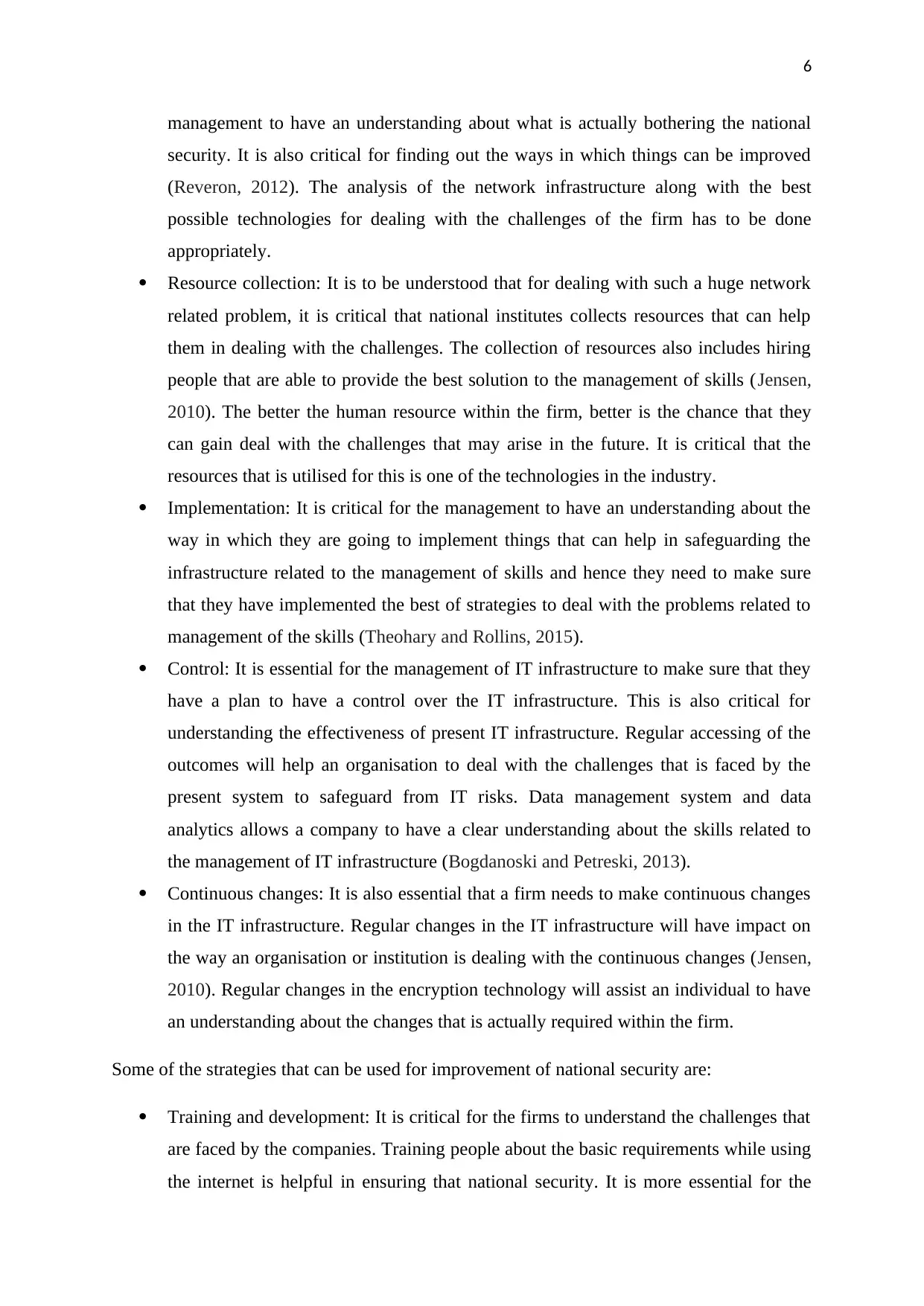
6
management to have an understanding about what is actually bothering the national
security. It is also critical for finding out the ways in which things can be improved
(Reveron, 2012). The analysis of the network infrastructure along with the best
possible technologies for dealing with the challenges of the firm has to be done
appropriately.
Resource collection: It is to be understood that for dealing with such a huge network
related problem, it is critical that national institutes collects resources that can help
them in dealing with the challenges. The collection of resources also includes hiring
people that are able to provide the best solution to the management of skills (Jensen,
2010). The better the human resource within the firm, better is the chance that they
can gain deal with the challenges that may arise in the future. It is critical that the
resources that is utilised for this is one of the technologies in the industry.
Implementation: It is critical for the management to have an understanding about the
way in which they are going to implement things that can help in safeguarding the
infrastructure related to the management of skills and hence they need to make sure
that they have implemented the best of strategies to deal with the problems related to
management of the skills (Theohary and Rollins, 2015).
Control: It is essential for the management of IT infrastructure to make sure that they
have a plan to have a control over the IT infrastructure. This is also critical for
understanding the effectiveness of present IT infrastructure. Regular accessing of the
outcomes will help an organisation to deal with the challenges that is faced by the
present system to safeguard from IT risks. Data management system and data
analytics allows a company to have a clear understanding about the skills related to
the management of IT infrastructure (Bogdanoski and Petreski, 2013).
Continuous changes: It is also essential that a firm needs to make continuous changes
in the IT infrastructure. Regular changes in the IT infrastructure will have impact on
the way an organisation or institution is dealing with the continuous changes (Jensen,
2010). Regular changes in the encryption technology will assist an individual to have
an understanding about the changes that is actually required within the firm.
Some of the strategies that can be used for improvement of national security are:
Training and development: It is critical for the firms to understand the challenges that
are faced by the companies. Training people about the basic requirements while using
the internet is helpful in ensuring that national security. It is more essential for the
management to have an understanding about what is actually bothering the national
security. It is also critical for finding out the ways in which things can be improved
(Reveron, 2012). The analysis of the network infrastructure along with the best
possible technologies for dealing with the challenges of the firm has to be done
appropriately.
Resource collection: It is to be understood that for dealing with such a huge network
related problem, it is critical that national institutes collects resources that can help
them in dealing with the challenges. The collection of resources also includes hiring
people that are able to provide the best solution to the management of skills (Jensen,
2010). The better the human resource within the firm, better is the chance that they
can gain deal with the challenges that may arise in the future. It is critical that the
resources that is utilised for this is one of the technologies in the industry.
Implementation: It is critical for the management to have an understanding about the
way in which they are going to implement things that can help in safeguarding the
infrastructure related to the management of skills and hence they need to make sure
that they have implemented the best of strategies to deal with the problems related to
management of the skills (Theohary and Rollins, 2015).
Control: It is essential for the management of IT infrastructure to make sure that they
have a plan to have a control over the IT infrastructure. This is also critical for
understanding the effectiveness of present IT infrastructure. Regular accessing of the
outcomes will help an organisation to deal with the challenges that is faced by the
present system to safeguard from IT risks. Data management system and data
analytics allows a company to have a clear understanding about the skills related to
the management of IT infrastructure (Bogdanoski and Petreski, 2013).
Continuous changes: It is also essential that a firm needs to make continuous changes
in the IT infrastructure. Regular changes in the IT infrastructure will have impact on
the way an organisation or institution is dealing with the continuous changes (Jensen,
2010). Regular changes in the encryption technology will assist an individual to have
an understanding about the changes that is actually required within the firm.
Some of the strategies that can be used for improvement of national security are:
Training and development: It is critical for the firms to understand the challenges that
are faced by the companies. Training people about the basic requirements while using
the internet is helpful in ensuring that national security. It is more essential for the
Paraphrase This Document
Need a fresh take? Get an instant paraphrase of this document with our AI Paraphraser
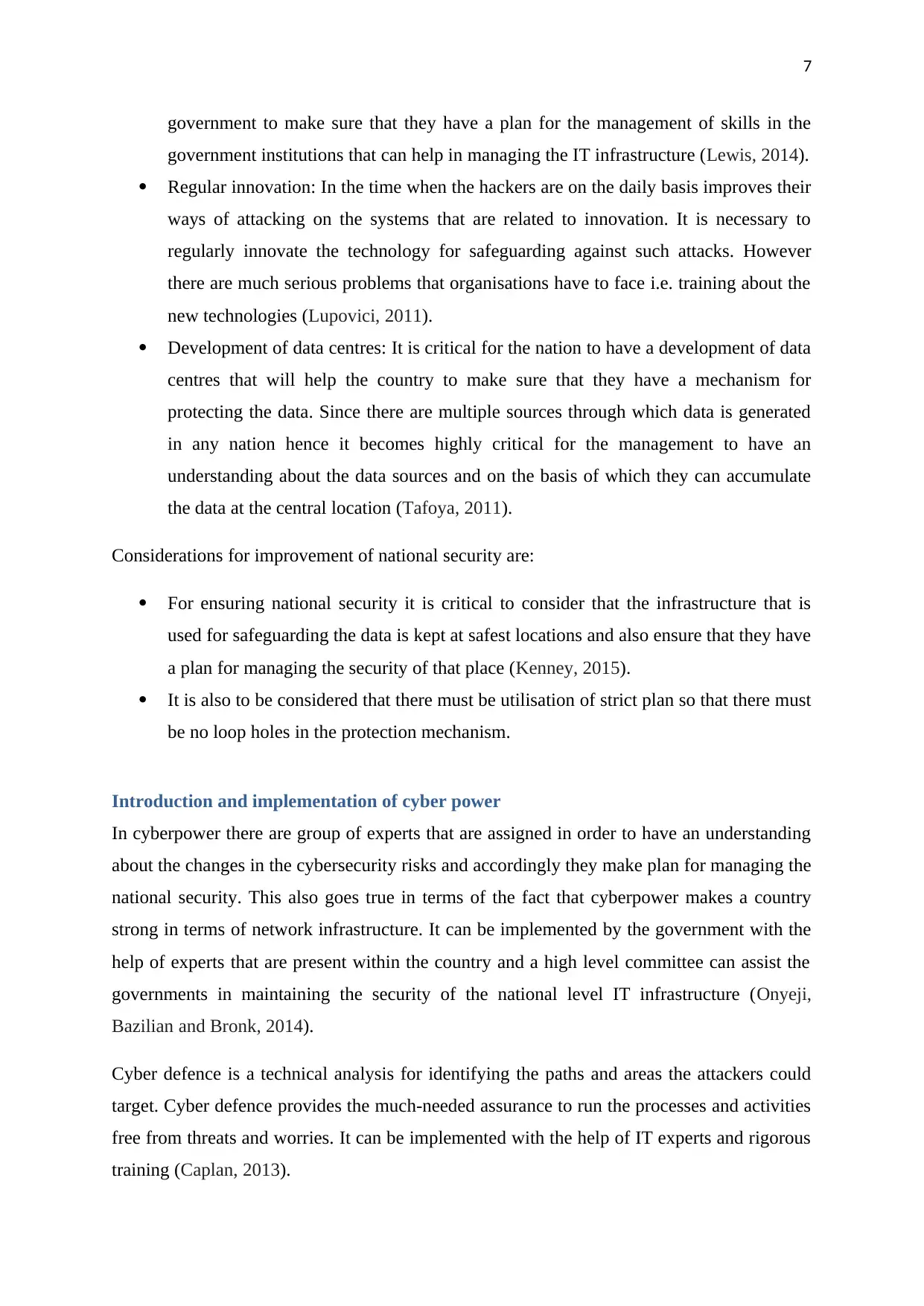
7
government to make sure that they have a plan for the management of skills in the
government institutions that can help in managing the IT infrastructure (Lewis, 2014).
Regular innovation: In the time when the hackers are on the daily basis improves their
ways of attacking on the systems that are related to innovation. It is necessary to
regularly innovate the technology for safeguarding against such attacks. However
there are much serious problems that organisations have to face i.e. training about the
new technologies (Lupovici, 2011).
Development of data centres: It is critical for the nation to have a development of data
centres that will help the country to make sure that they have a mechanism for
protecting the data. Since there are multiple sources through which data is generated
in any nation hence it becomes highly critical for the management to have an
understanding about the data sources and on the basis of which they can accumulate
the data at the central location (Tafoya, 2011).
Considerations for improvement of national security are:
For ensuring national security it is critical to consider that the infrastructure that is
used for safeguarding the data is kept at safest locations and also ensure that they have
a plan for managing the security of that place (Kenney, 2015).
It is also to be considered that there must be utilisation of strict plan so that there must
be no loop holes in the protection mechanism.
Introduction and implementation of cyber power
In cyberpower there are group of experts that are assigned in order to have an understanding
about the changes in the cybersecurity risks and accordingly they make plan for managing the
national security. This also goes true in terms of the fact that cyberpower makes a country
strong in terms of network infrastructure. It can be implemented by the government with the
help of experts that are present within the country and a high level committee can assist the
governments in maintaining the security of the national level IT infrastructure (Onyeji,
Bazilian and Bronk, 2014).
Cyber defence is a technical analysis for identifying the paths and areas the attackers could
target. Cyber defence provides the much-needed assurance to run the processes and activities
free from threats and worries. It can be implemented with the help of IT experts and rigorous
training (Caplan, 2013).
government to make sure that they have a plan for the management of skills in the
government institutions that can help in managing the IT infrastructure (Lewis, 2014).
Regular innovation: In the time when the hackers are on the daily basis improves their
ways of attacking on the systems that are related to innovation. It is necessary to
regularly innovate the technology for safeguarding against such attacks. However
there are much serious problems that organisations have to face i.e. training about the
new technologies (Lupovici, 2011).
Development of data centres: It is critical for the nation to have a development of data
centres that will help the country to make sure that they have a mechanism for
protecting the data. Since there are multiple sources through which data is generated
in any nation hence it becomes highly critical for the management to have an
understanding about the data sources and on the basis of which they can accumulate
the data at the central location (Tafoya, 2011).
Considerations for improvement of national security are:
For ensuring national security it is critical to consider that the infrastructure that is
used for safeguarding the data is kept at safest locations and also ensure that they have
a plan for managing the security of that place (Kenney, 2015).
It is also to be considered that there must be utilisation of strict plan so that there must
be no loop holes in the protection mechanism.
Introduction and implementation of cyber power
In cyberpower there are group of experts that are assigned in order to have an understanding
about the changes in the cybersecurity risks and accordingly they make plan for managing the
national security. This also goes true in terms of the fact that cyberpower makes a country
strong in terms of network infrastructure. It can be implemented by the government with the
help of experts that are present within the country and a high level committee can assist the
governments in maintaining the security of the national level IT infrastructure (Onyeji,
Bazilian and Bronk, 2014).
Cyber defence is a technical analysis for identifying the paths and areas the attackers could
target. Cyber defence provides the much-needed assurance to run the processes and activities
free from threats and worries. It can be implemented with the help of IT experts and rigorous
training (Caplan, 2013).
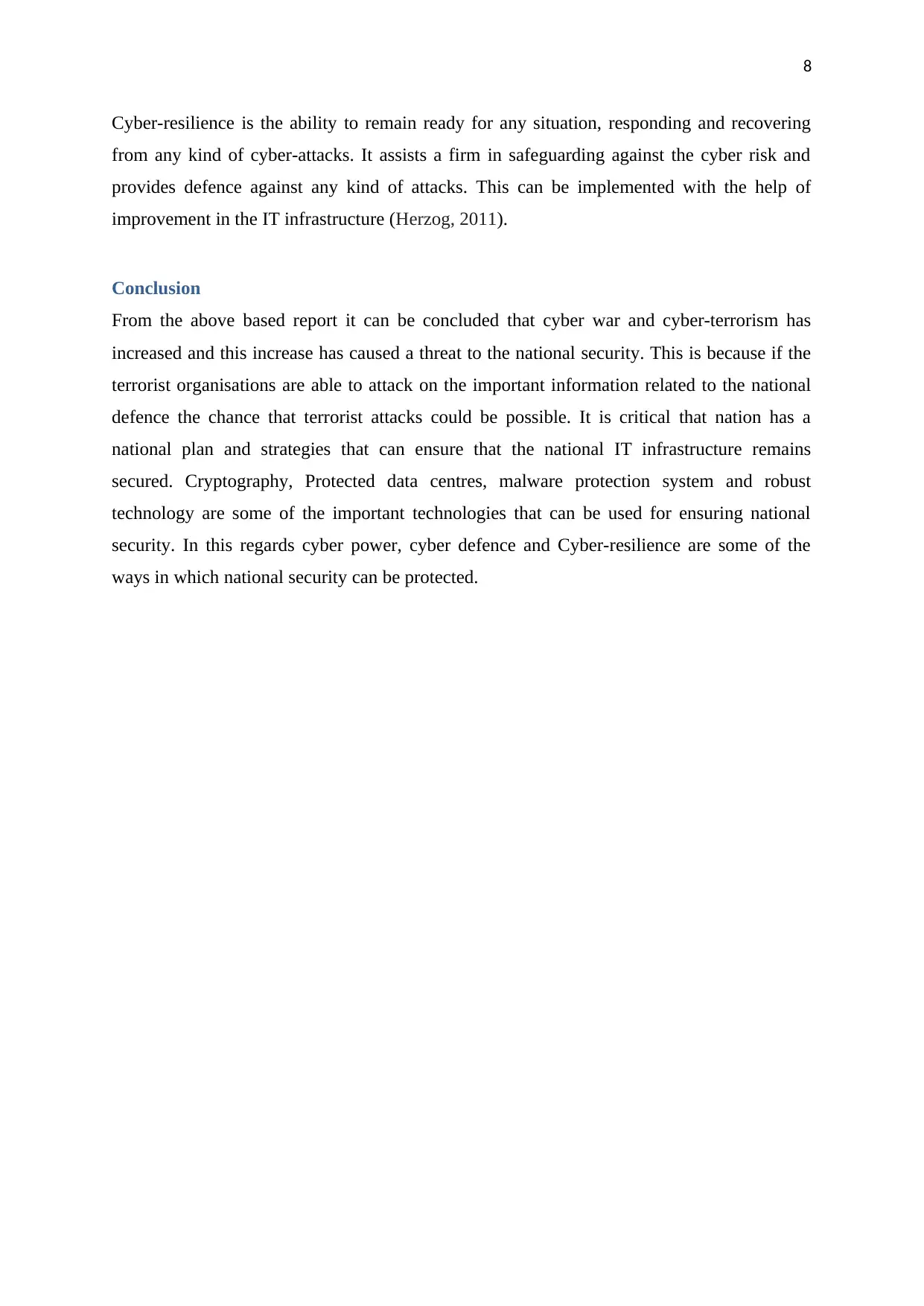
8
Cyber-resilience is the ability to remain ready for any situation, responding and recovering
from any kind of cyber-attacks. It assists a firm in safeguarding against the cyber risk and
provides defence against any kind of attacks. This can be implemented with the help of
improvement in the IT infrastructure (Herzog, 2011).
Conclusion
From the above based report it can be concluded that cyber war and cyber-terrorism has
increased and this increase has caused a threat to the national security. This is because if the
terrorist organisations are able to attack on the important information related to the national
defence the chance that terrorist attacks could be possible. It is critical that nation has a
national plan and strategies that can ensure that the national IT infrastructure remains
secured. Cryptography, Protected data centres, malware protection system and robust
technology are some of the important technologies that can be used for ensuring national
security. In this regards cyber power, cyber defence and Cyber-resilience are some of the
ways in which national security can be protected.
Cyber-resilience is the ability to remain ready for any situation, responding and recovering
from any kind of cyber-attacks. It assists a firm in safeguarding against the cyber risk and
provides defence against any kind of attacks. This can be implemented with the help of
improvement in the IT infrastructure (Herzog, 2011).
Conclusion
From the above based report it can be concluded that cyber war and cyber-terrorism has
increased and this increase has caused a threat to the national security. This is because if the
terrorist organisations are able to attack on the important information related to the national
defence the chance that terrorist attacks could be possible. It is critical that nation has a
national plan and strategies that can ensure that the national IT infrastructure remains
secured. Cryptography, Protected data centres, malware protection system and robust
technology are some of the important technologies that can be used for ensuring national
security. In this regards cyber power, cyber defence and Cyber-resilience are some of the
ways in which national security can be protected.
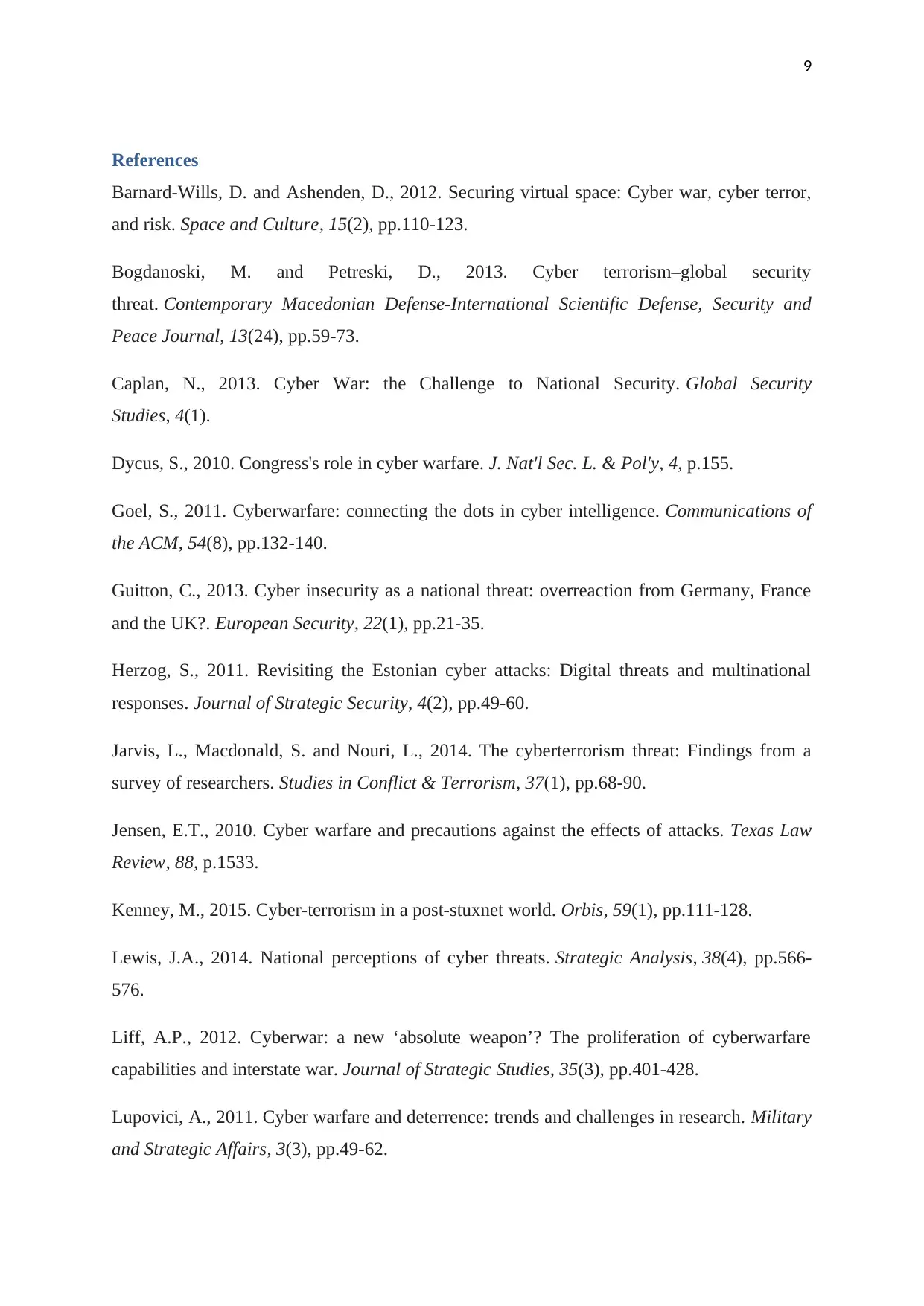
9
References
Barnard-Wills, D. and Ashenden, D., 2012. Securing virtual space: Cyber war, cyber terror,
and risk. Space and Culture, 15(2), pp.110-123.
Bogdanoski, M. and Petreski, D., 2013. Cyber terrorism–global security
threat. Contemporary Macedonian Defense-International Scientific Defense, Security and
Peace Journal, 13(24), pp.59-73.
Caplan, N., 2013. Cyber War: the Challenge to National Security. Global Security
Studies, 4(1).
Dycus, S., 2010. Congress's role in cyber warfare. J. Nat'l Sec. L. & Pol'y, 4, p.155.
Goel, S., 2011. Cyberwarfare: connecting the dots in cyber intelligence. Communications of
the ACM, 54(8), pp.132-140.
Guitton, C., 2013. Cyber insecurity as a national threat: overreaction from Germany, France
and the UK?. European Security, 22(1), pp.21-35.
Herzog, S., 2011. Revisiting the Estonian cyber attacks: Digital threats and multinational
responses. Journal of Strategic Security, 4(2), pp.49-60.
Jarvis, L., Macdonald, S. and Nouri, L., 2014. The cyberterrorism threat: Findings from a
survey of researchers. Studies in Conflict & Terrorism, 37(1), pp.68-90.
Jensen, E.T., 2010. Cyber warfare and precautions against the effects of attacks. Texas Law
Review, 88, p.1533.
Kenney, M., 2015. Cyber-terrorism in a post-stuxnet world. Orbis, 59(1), pp.111-128.
Lewis, J.A., 2014. National perceptions of cyber threats. Strategic Analysis, 38(4), pp.566-
576.
Liff, A.P., 2012. Cyberwar: a new ‘absolute weapon’? The proliferation of cyberwarfare
capabilities and interstate war. Journal of Strategic Studies, 35(3), pp.401-428.
Lupovici, A., 2011. Cyber warfare and deterrence: trends and challenges in research. Military
and Strategic Affairs, 3(3), pp.49-62.
References
Barnard-Wills, D. and Ashenden, D., 2012. Securing virtual space: Cyber war, cyber terror,
and risk. Space and Culture, 15(2), pp.110-123.
Bogdanoski, M. and Petreski, D., 2013. Cyber terrorism–global security
threat. Contemporary Macedonian Defense-International Scientific Defense, Security and
Peace Journal, 13(24), pp.59-73.
Caplan, N., 2013. Cyber War: the Challenge to National Security. Global Security
Studies, 4(1).
Dycus, S., 2010. Congress's role in cyber warfare. J. Nat'l Sec. L. & Pol'y, 4, p.155.
Goel, S., 2011. Cyberwarfare: connecting the dots in cyber intelligence. Communications of
the ACM, 54(8), pp.132-140.
Guitton, C., 2013. Cyber insecurity as a national threat: overreaction from Germany, France
and the UK?. European Security, 22(1), pp.21-35.
Herzog, S., 2011. Revisiting the Estonian cyber attacks: Digital threats and multinational
responses. Journal of Strategic Security, 4(2), pp.49-60.
Jarvis, L., Macdonald, S. and Nouri, L., 2014. The cyberterrorism threat: Findings from a
survey of researchers. Studies in Conflict & Terrorism, 37(1), pp.68-90.
Jensen, E.T., 2010. Cyber warfare and precautions against the effects of attacks. Texas Law
Review, 88, p.1533.
Kenney, M., 2015. Cyber-terrorism in a post-stuxnet world. Orbis, 59(1), pp.111-128.
Lewis, J.A., 2014. National perceptions of cyber threats. Strategic Analysis, 38(4), pp.566-
576.
Liff, A.P., 2012. Cyberwar: a new ‘absolute weapon’? The proliferation of cyberwarfare
capabilities and interstate war. Journal of Strategic Studies, 35(3), pp.401-428.
Lupovici, A., 2011. Cyber warfare and deterrence: trends and challenges in research. Military
and Strategic Affairs, 3(3), pp.49-62.
Secure Best Marks with AI Grader
Need help grading? Try our AI Grader for instant feedback on your assignments.
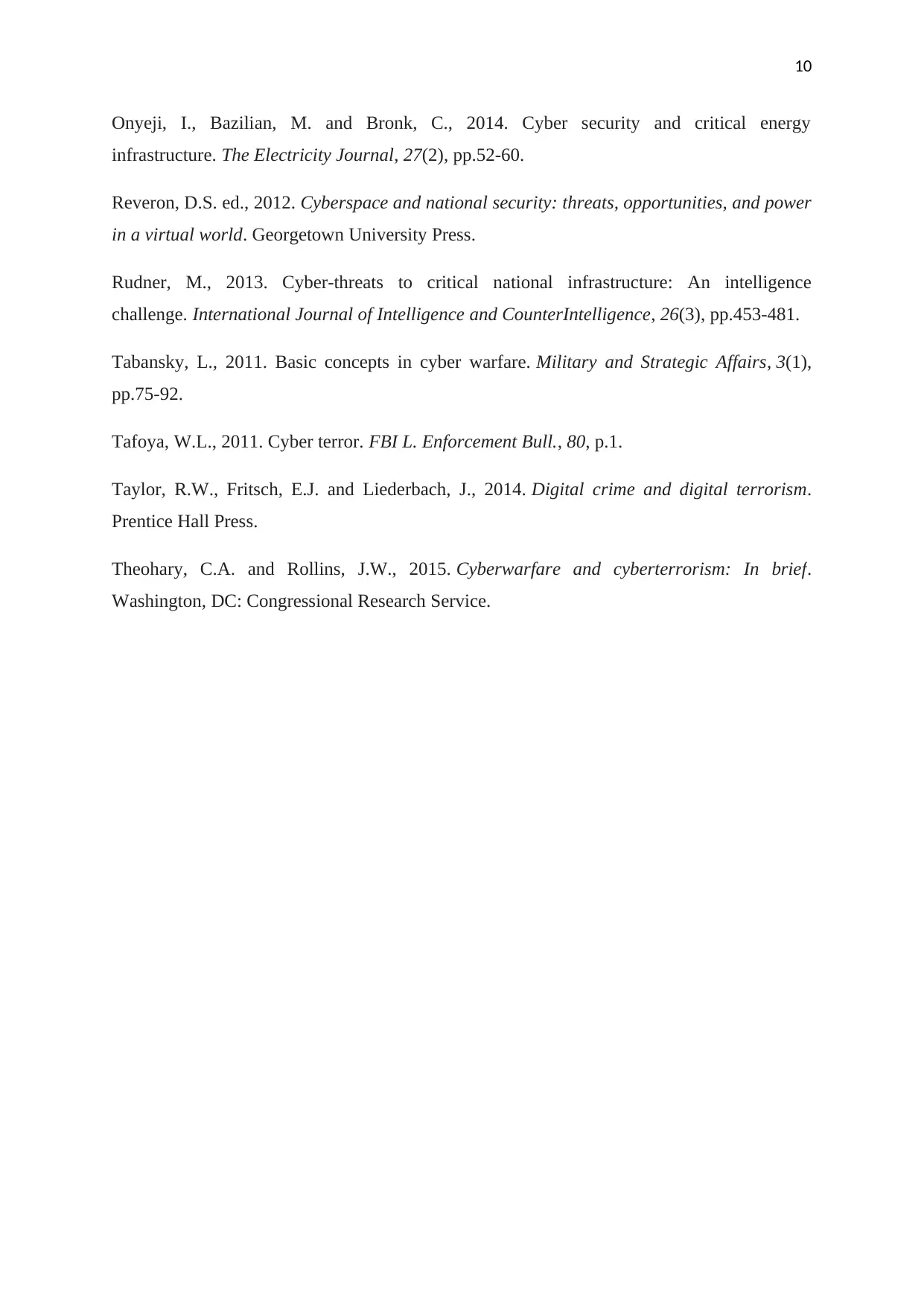
10
Onyeji, I., Bazilian, M. and Bronk, C., 2014. Cyber security and critical energy
infrastructure. The Electricity Journal, 27(2), pp.52-60.
Reveron, D.S. ed., 2012. Cyberspace and national security: threats, opportunities, and power
in a virtual world. Georgetown University Press.
Rudner, M., 2013. Cyber-threats to critical national infrastructure: An intelligence
challenge. International Journal of Intelligence and CounterIntelligence, 26(3), pp.453-481.
Tabansky, L., 2011. Basic concepts in cyber warfare. Military and Strategic Affairs, 3(1),
pp.75-92.
Tafoya, W.L., 2011. Cyber terror. FBI L. Enforcement Bull., 80, p.1.
Taylor, R.W., Fritsch, E.J. and Liederbach, J., 2014. Digital crime and digital terrorism.
Prentice Hall Press.
Theohary, C.A. and Rollins, J.W., 2015. Cyberwarfare and cyberterrorism: In brief.
Washington, DC: Congressional Research Service.
Onyeji, I., Bazilian, M. and Bronk, C., 2014. Cyber security and critical energy
infrastructure. The Electricity Journal, 27(2), pp.52-60.
Reveron, D.S. ed., 2012. Cyberspace and national security: threats, opportunities, and power
in a virtual world. Georgetown University Press.
Rudner, M., 2013. Cyber-threats to critical national infrastructure: An intelligence
challenge. International Journal of Intelligence and CounterIntelligence, 26(3), pp.453-481.
Tabansky, L., 2011. Basic concepts in cyber warfare. Military and Strategic Affairs, 3(1),
pp.75-92.
Tafoya, W.L., 2011. Cyber terror. FBI L. Enforcement Bull., 80, p.1.
Taylor, R.W., Fritsch, E.J. and Liederbach, J., 2014. Digital crime and digital terrorism.
Prentice Hall Press.
Theohary, C.A. and Rollins, J.W., 2015. Cyberwarfare and cyberterrorism: In brief.
Washington, DC: Congressional Research Service.
1 out of 11
Related Documents
Your All-in-One AI-Powered Toolkit for Academic Success.
+13062052269
info@desklib.com
Available 24*7 on WhatsApp / Email
![[object Object]](/_next/static/media/star-bottom.7253800d.svg)
Unlock your academic potential
© 2024 | Zucol Services PVT LTD | All rights reserved.





